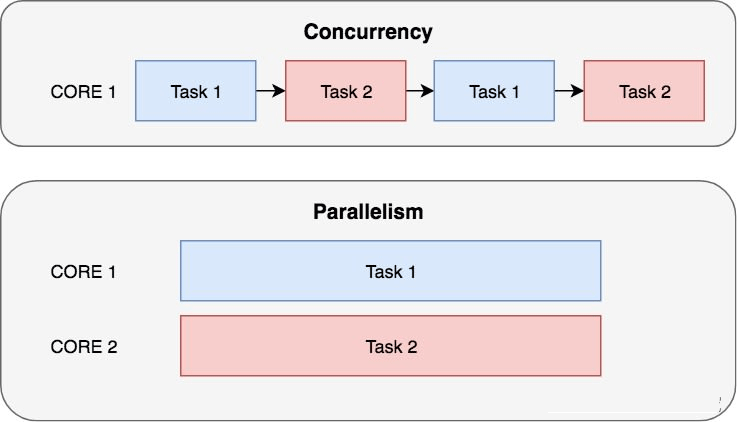жӮЁеҘҪпјҢзҷ»еҪ•еҗҺжүҚиғҪдёӢи®ўеҚ•е“ҰпјҒ
иҝҷзҜҮж–Үз« дё»иҰҒи®Іи§ЈдәҶвҖңPythonеӨҡиҝӣзЁӢ,еӨҡзәҝзЁӢеҸҠGILе…ЁеұҖи§ЈйҮҠеҷЁй”Ғе®һдҫӢеҲҶжһҗвҖқпјҢж–Үдёӯзҡ„и®Іи§ЈеҶ…е®№з®ҖеҚ•жё…жҷ°пјҢжҳ“дәҺеӯҰд№ дёҺзҗҶи§ЈпјҢдёӢйқўиҜ·еӨ§е®¶и·ҹзқҖе°Ҹзј–зҡ„жҖқи·Ҝж…ўж…ўж·ұе…ҘпјҢдёҖиө·жқҘз ”з©¶е’ҢеӯҰд№ вҖңPythonеӨҡиҝӣзЁӢ,еӨҡзәҝзЁӢеҸҠGILе…ЁеұҖи§ЈйҮҠеҷЁй”Ғе®һдҫӢеҲҶжһҗвҖқеҗ§пјҒ
жүҖи°“зҡ„并иЎҢпјҲParallelismпјүпјҢе°ұжҳҜеӨҡдёӘеҪјжӯӨзӢ¬з«Ӣзҡ„д»»еҠЎеҸҜд»ҘеҗҢж—¶дёҖиө·жү§иЎҢпјҢеҪјжӯӨ并дёҚзӣёдә’е№Іжү°пјҢ并иЎҢејәи°ғзҡ„жҳҜеҗҢж—¶дё”зӢ¬з«Ӣзҡ„иҝҗиЎҢпјҢеҪјжӯӨдёҚйңҖиҰҒеҚҸдҪңгҖӮ
иҖҢжүҖ谓并еҸ‘пјҲConcurrencyпјүпјҢеҲҷжҳҜеӨҡдёӘд»»еҠЎеҪјжӯӨдәӨжӣҝжү§иЎҢпјҢдҪҶжҳҜеҗҢдёҖж—¶й—ҙеҸӘиғҪжңүдёҖдёӘеӨ„дәҺиҝҗиЎҢзҠ¶жҖҒпјҢ并еҸ‘жү§иЎҢејәи°ғд»»еҠЎд№Ӣй—ҙзҡ„еҪјжӯӨеҚҸдҪңгҖӮ
并еҸ‘йҖҡеёёиў«иҜҜи§Јдёә并иЎҢпјҢ并еҸ‘е®һйҷ…жҳҜйҡҗејҸзҡ„и°ғеәҰзӢ¬з«Ӣзҡ„д»Јз ҒпјҢд»ҘеҚҸдҪңзҡ„ж–№ејҸиҝҗиЎҢгҖӮжҜ”еҰӮеңЁзӯүеҫ…IOзәҝзЁӢе®ҢжҲҗIOж“ҚдҪңд№ӢеүҚпјҢеҸҜд»ҘеҗҜеҠЁIOзәҝзЁӢд№ӢеӨ–зҡ„е…¶д»–зӢ¬з«Ӣд»Јз ҒеҗҢжӯҘжү§иЎҢе…¶д»–ж“ҚдҪңгҖӮ
е…ідәҺ并еҸ‘гҖҒ并иЎҢзҡ„еӣҫзӨәпјҢеҰӮдёӢпјҡ

з”ұдәҺCPythonи§ЈйҮҠеҷЁдёӯзҡ„е…ЁеұҖи§ЈйҮҠеҷЁй”ҒпјҲGILпјҢGlobal Interpreter Lockпјүзҡ„еӯҳеңЁпјҢжүҖд»ҘPythonдёӯзҡ„并иЎҢе®һйҷ…дёҠжҳҜдёҖз§ҚеҒҮ并иЎҢпјҢ并дёҚжҳҜзңҹжӯЈж„Ҹд№үдёҠзҡ„еҗҢж—¶зӢ¬з«ӢиҝҗиЎҢгҖӮ
иҝӣзЁӢпјҲProcessпјүжҳҜж“ҚдҪңзі»з»ҹеұӮйқўзҡ„дёҖдёӘжҠҪиұЎжҰӮеҝөпјҢе®ғжҳҜиҝҗиЎҢд»Јз ҒеҲӣе»әеҮәжқҘзҡ„гҖҒеҠ иҪҪеҲ°еҶ…еӯҳдёӯиҝҗиЎҢзҡ„зЁӢеәҸгҖӮз”өи„‘дёҠйҖҡеёёиҝҗиЎҢзқҖеӨҡдёӘиҝӣзЁӢпјҢиҝҷдәӣиҝӣзЁӢд№Ӣй—ҙжҳҜеҪјжӯӨзӢ¬з«ӢиҝҗиЎҢзҡ„гҖӮ
зәҝзЁӢпјҲThreadпјүжҳҜж“ҚдҪңзі»з»ҹеҸҜд»Ҙи°ғеәҰзҡ„жңҖе°ҸиҝҗиЎҢзЁӢеәҸеҚ•дҪҚпјҢе…¶еҢ…еҗ«еңЁиҝӣзЁӢдёӯпјҢдёҖдёӘиҝӣзЁӢдёӯйҖҡеёёиҮіе°‘еҢ…еҗ«1дёӘзәҝзЁӢпјҢдёҖдәӣиҝӣзЁӢдёӯдјҡеҢ…еҗ«еӨҡдёӘзәҝзЁӢгҖӮеӨҡдёӘзәҝзЁӢиҝҗиЎҢзҡ„йғҪжҳҜзҲ¶иҝӣзЁӢзҡ„зӣёеҗҢд»Јз ҒпјҢзҗҶжғіжғ…еҶөдёӢпјҢиҝҷдәӣзәҝзЁӢжҳҜ并иЎҢжү§иЎҢзҡ„пјҢдҪҶз”ұдәҺGILзҡ„еӯҳеңЁпјҢжүҖд»Ҙе®ғ们е®һйҷ…дёҠжҳҜдәӨжӣҝжү§иЎҢзҡ„пјҢ并дёҚжҳҜзңҹжӯЈж„Ҹд№үдёҠзҡ„зӢ¬з«ӢгҖҒ并иЎҢзҡ„жү§иЎҢзҡ„гҖӮ
дёӢиЎЁжҳҜиҝӣзЁӢдёҺзәҝзЁӢзҡ„еҜ№жҜ”пјҡ

еҜ№дәҺIOеҜҶйӣҶеһӢзҡ„ж“ҚдҪңпјҢжӣҙйҖӮеҗҲдҪҝз”ЁеӨҡзәҝзЁӢзј–зЁӢзҡ„ж–№ејҸжқҘи§ЈеҶій—®йўҳпјӣеҜ№дәҺCPUеҜҶйӣҶеһӢзҡ„ж“ҚдҪңпјҢеҲҷжӣҙйҖӮеҗҲдҪҝз”ЁеӨҡиҝӣзЁӢзј–зЁӢзҡ„ж–№ејҸжқҘи§ЈеҶій—®йўҳгҖӮ
PythonдёӯжҸҗдҫӣдәҶдёҖдәӣжЁЎеқ—з”ЁдәҺе®һзҺ°е№¶иЎҢ/并еҸ‘зј–зЁӢпјҢе…·дҪ“еҰӮдёӢжүҖзӨәпјҡ
threadingпјҡPythonдёӯиҝӣиЎҢеӨҡзәҝзЁӢзј–зЁӢзҡ„ж ҮеҮҶеә“пјҢжҳҜдёҖдёӘеҜ№_threadиҝӣиЎҢеҶҚе°ҒиЈ…зҡ„й«ҳзә§жЁЎеқ—гҖӮmultiprocessingпјҡзұ»дјјдәҺthreadingжЁЎеқ—пјҢжҸҗдҫӣзҡ„APIжҺҘеҸЈд№ҹдёҺthreadingжЁЎеқ—зұ»дјјпјҢдёҚеҗҢзҡ„жҳҜе®ғиҝӣиЎҢеӨҡиҝӣзЁӢзј–зЁӢгҖӮconcurrent.futuresпјҡж ҮеҮҶеә“дёӯзҡ„дёҖдёӘжЁЎеқ—пјҢеңЁзәҝзЁӢзј–зЁӢжЁЎеқ—зҡ„еҹәзЎҖдёҠжҠҪиұЎеҮәжқҘзҡ„жӣҙй«ҳзә§е®һзҺ°пјҢдё”иҜҘжЁЎеқ—зҡ„зј–зЁӢдёәејӮжӯҘжЁЎејҸгҖӮqueueпјҡд»»еҠЎйҳҹеҲ—жЁЎеқ—пјҢqueueдёӯжҸҗдҫӣзҡ„йҳҹеҲ—жҳҜзәҝзЁӢе®үе…Ёзҡ„пјҢжүҖд»ҘеҸҜд»ҘдҪҝз”ЁиҝҷдёӘжЁЎеқ—иҝӣиЎҢзәҝзЁӢд№Ӣй—ҙиҝӣиЎҢе®үе…Ёзҡ„ж•°жҚ®дәӨжҚўж“ҚдҪңгҖӮдёҚж”ҜжҢҒеҲҶеёғејҸгҖӮceleryпјҡдёҖдёӘй«ҳзә§зҡ„еҲҶеёғејҸд»»еҠЎйҳҹеҲ—пјҢйҖҡиҝҮmultiprocessingжЁЎеқ—жҲ–иҖ…geventжЁЎеқ—еҸҜд»Ҙе®һзҺ°йҳҹеҲ—дёӯдәәзү©зҡ„并еҸ‘жү§иЎҢгҖӮж”ҜжҢҒеӨҡиҠӮзӮ№д№Ӣй—ҙзҡ„еҲҶеёғејҸи®Ўз®—гҖӮ 2.2. йҖҡиҝҮзј–з ҒжҜ”иҫғеӨҡиҝӣзЁӢдёҺеӨҡзәҝзЁӢзҡ„жү§иЎҢж•Ҳжһң
еңЁдёӢйқўзҡ„д»Јз ҒдёӯпјҢе®ҡд№үдәҶдёӨдёӘеҮҪж•°пјҡonly_sleep()д»ҘеҸҠcrunch_numbers()пјҢеүҚиҖ…з”ЁдәҺжЁЎжӢҹIOеҜҶйӣҶеһӢж“ҚдҪңпјҲйңҖиҰҒйў‘з№Ғдёӯж–ӯпјүпјҢеҗҺиҖ…з”ЁдәҺжЁЎжӢҹCPUеҜҶйӣҶеһӢж“ҚдҪңгҖӮ
然еҗҺеңЁдёІиЎҢи°ғз”ЁгҖҒеӨҡзәҝзЁӢзҡ„ж–№ејҸи°ғз”ЁгҖҒеӨҡиҝӣзЁӢзҡ„ж–№ејҸи°ғз”ЁпјҢдёүз§ҚдёҚеҗҢзҡ„жү§иЎҢзҺҜеўғдёӯпјҢжҜ”иҫғеҗ„дёӘеҮҪж•°зҡ„жү§иЎҢж•ҲзҺҮжғ…еҶөгҖӮ
е…·дҪ“д»Јз Ғд»ҘеҸҠжү§иЎҢз»“жһңеҰӮдёӢжүҖзӨәпјҡ
import time
import datetime
import logging
import threading
import multiprocessing
FORMAT = "%(asctime)s [%(processName)s %(process)d] %(threadName)s %(thread)d <=%(message)s=>"
logging.basicConfig(format=FORMAT, level=logging.INFO, datefmt='%H:%M:%S')
def only_sleep():
"""
жЁЎжӢҹIOйҳ»еЎһеһӢж“ҚдҪңпјҢжӯӨж—¶еӨҡзәҝзЁӢдјҳеҠҝжҳҺжҳҫ
:return:
"""
logging.info('in only_sleep function')
time.sleep(1)
def crunch_numbers():
"""
жЁЎжӢҹCPUеҜҶйӣҶеһӢж“ҚдҪңпјҢжӯӨж—¶еӨҡиҝӣзЁӢдјҳеҠҝжҳҺжҳҫ
:return:
"""
logging.info('in crunch_numbers function')
x = 0
while x < 1000000:
x += 1
if __name__ == '__main__':
work_repeat = 4
print('==>> only_sleep function test')
count = 0
for func in (only_sleep, crunch_numbers):
count += 1
# run tasks serially
start1 = datetime.datetime.now()
for i in range(work_repeat):
func()
stop1 = datetime.datetime.now()
delta1 = (stop1 - start1).total_seconds()
print('Serial Execution takes {} seconds~'.format(delta1))
# run tasks with multi-threads
start2 = datetime.datetime.now()
thread_lst = [threading.Thread(target=func, name='thread-worker' + str(i)) for i in range(work_repeat)]
[thd.start() for thd in thread_lst]
[thd.join() for thd in thread_lst]
stop2 = datetime.datetime.now()
delta2 = (stop2 - start2).total_seconds()
print('Multi-Threads takes {} seconds~'.format(delta2))
# run tasks with multiprocessing
start3 = datetime.datetime.now()
proc_lst = [multiprocessing.Process(target=func, name='process-worker' + str(i)) for i in range(work_repeat)]
[thd.start() for thd in proc_lst]
[thd.join() for thd in proc_lst]
stop3 = datetime.datetime.now()
delta3 = (stop3 - start3).total_seconds()
print('Multi-Processing takes {} seconds~'.format(delta3))
if count == 1:
print('\n', '*.' * 30, end='\n\n')
print('==>> crunch_numbers function test')дёҠиҝ°д»Јз Ғзҡ„жү§иЎҢз»“жһңеҰӮдёӢпјҡ
23:55:51 [MainProcess 568124] MainThread 182168 <=in only_sleep function=>
==>> only_sleep function test
23:55:52 [MainProcess 568124] MainThread 182168 <=in only_sleep function=>
23:55:53 [MainProcess 568124] MainThread 182168 <=in only_sleep function=>
23:55:54 [MainProcess 568124] MainThread 182168 <=in only_sleep function=>
23:55:55 [MainProcess 568124] thread-worker0 553012 <=in only_sleep function=>
23:55:55 [MainProcess 568124] thread-worker1 567212 <=in only_sleep function=>
23:55:55 [MainProcess 568124] thread-worker2 547252 <=in only_sleep function=>
23:55:55 [MainProcess 568124] thread-worker3 561892 <=in only_sleep function=>
Serial Execution takes 4.022761 seconds~
Multi-Threads takes 1.01416 seconds~
23:55:56 [process-worker0 563068] MainThread 567480 <=in only_sleep function=>
23:55:56 [process-worker1 567080] MainThread 567628 <=in only_sleep function=>
23:55:56 [process-worker2 567868] MainThread 563656 <=in only_sleep function=>
23:55:56 [process-worker3 567444] MainThread 566436 <=in only_sleep function=>
23:55:57 [MainProcess 568124] MainThread 182168 <=in crunch_numbers function=>
Multi-Processing takes 1.11466 seconds~*.*.*.*.*.*.*.*.*.*.*.*.*.*.*.*.*.*.*.*.*.*.*.*.*.*.*.*.*.*.
==>> crunch_numbers function test
23:55:57 [MainProcess 568124] MainThread 182168 <=in crunch_numbers function=>
23:55:57 [MainProcess 568124] MainThread 182168 <=in crunch_numbers function=>
23:55:57 [MainProcess 568124] MainThread 182168 <=in crunch_numbers function=>
Serial Execution takes 0.1786 seconds~
23:55:57 [MainProcess 568124] thread-worker0 567412 <=in crunch_numbers function=>
23:55:57 [MainProcess 568124] thread-worker1 566468 <=in crunch_numbers function=>
23:55:57 [MainProcess 568124] thread-worker2 565272 <=in crunch_numbers function=>
23:55:57 [MainProcess 568124] thread-worker3 568044 <=in crunch_numbers function=>
Multi-Threads takes 0.195057 seconds~
23:55:58 [process-worker0 567652] MainThread 561892 <=in crunch_numbers function=>
23:55:58 [process-worker1 553012] MainThread 547252 <=in crunch_numbers function=>
23:55:58 [process-worker2 554024] MainThread 556500 <=in crunch_numbers function=>
23:55:58 [process-worker3 565004] MainThread 566108 <=in crunch_numbers function=>
Multi-Processing takes 0.155246 seconds~Process finished with exit code 0
д»ҺдёҠиҝ°жү§иЎҢз»“жһңдёӯеҸҜд»ҘзңӢеҮәпјҡ
дёҠиҝ°д»Јз Ғзҡ„жү§иЎҢз»“жһңд№ҹйӘҢиҜҒдәҶжӯӨеүҚзҡ„з»“и®әпјҡеҜ№дәҺIOеҜҶйӣҶеһӢж“ҚдҪңпјҢйҖӮеҗҲдҪҝз”ЁеӨҡзәҝзЁӢзј–зЁӢзҡ„ж–№ејҸи§ЈеҶій—®йўҳпјӣиҖҢеҜ№дәҺCPUеҜҶйӣҶеһӢзҡ„ж“ҚдҪңпјҢеҲҷйҖӮеҗҲдҪҝз”ЁеӨҡиҝӣзЁӢзј–зЁӢзҡ„ж–№ејҸи§ЈеҶій—®йўҳгҖӮ
GILжҳҜCPythonдёӯе®һзҺ°зҡ„е…ЁеұҖи§ЈйҮҠеҷЁй”Ғ (Global Interpreter Lock)пјҢз”ұдәҺCPythonжҳҜдҪҝз”ЁжңҖе№ҝжіӣзҡ„Pythonи§ЈйҮҠеҷЁпјҢжүҖд»ҘGILд№ҹжҳҜPythonдё–з•ҢдёӯжңҖйҘұеҸ—дәүи®®зҡ„дёҖдёӘдё»йўҳгҖӮ
GILжҳҜдә’ж–Ҙй”ҒпјҢе…¶зӣ®зҡ„жҳҜдёәдәҶзЎ®дҝқзәҝзЁӢе®үе…ЁпјҢжӯЈжҳҜеӣ дёәжңүдәҶGILпјҢжүҖд»ҘеҸҜд»ҘеҫҲж–№дҫҝзҡ„дёҺеӨ–йғЁйқһзәҝзЁӢе®үе…Ёзҡ„жЁЎеқ—жҲ–иҖ…еә“з»“еҗҲиө·жқҘгҖӮдҪҶжҳҜиҝҷд№ҹжҳҜжңүд»Јд»·зҡ„пјҢз”ұдәҺжңүдәҶGILпјҢжүҖд»ҘеҜјиҮҙPythonдёӯзҡ„并иЎҢ并дёҚжҳҜзңҹжӯЈж„Ҹд№үдёҠзҡ„并иЎҢпјҢжүҖд»Ҙд№ҹе°ұж— жі•еҗҢж—¶еҲӣе»әдёӨдёӘдҪҝз”ЁзӣёеҗҢд»Јз Ғж®өзҡ„зәҝзЁӢпјҢзӣёеҗҢд»Јз Ғзҡ„зәҝзЁӢеҸӘиғҪжңүдёҖдёӘеӨ„дәҺжү§иЎҢзҠ¶жҖҒгҖӮеӣ дёәGILдә’ж–Ҙй”ҒпјҢзӣёеҗҢд»Јз Ғи®ҝй—®зҡ„ж•°жҚ®дјҡиў«еҠ й”ҒпјҢеҸӘжңүеҪ“дёҖдёӘзәҝзЁӢйҮҠж”ҫй”Ғд№ӢеҗҺпјҢзӣёеҗҢд»Јз Ғзҡ„еҸҰдёҖдёӘзәҝзЁӢжүҚиғҪи®ҝй—®жңӘиў«еҠ й”Ғзҡ„ж•°жҚ®гҖӮ
жүҖд»ҘPythonдёӯзҡ„еӨҡзәҝзЁӢжҳҜзӣёдә’дәӨжӣҝжү§иЎҢзҡ„пјҢ并дёҚжҳҜзңҹжӯЈзҡ„并иЎҢжү§иЎҢзҡ„гҖӮдҪҶжҳҜеңЁCPythonд№ӢеӨ–зҡ„дёҖдәӣеә“пјҢжҳҜеҸҜд»Ҙе®һзҺ°зңҹжӯЈж„Ҹд№үдёҠзҡ„并иЎҢзҡ„пјҢжҜ”еҰӮnumpyиҝҷдёӘж•°жҚ®еӨ„зҗҶеёёз”Ёзҡ„еә“гҖӮ
ж„ҹи°ўеҗ„дҪҚзҡ„йҳ…иҜ»пјҢд»ҘдёҠе°ұжҳҜвҖңPythonеӨҡиҝӣзЁӢ,еӨҡзәҝзЁӢеҸҠGILе…ЁеұҖи§ЈйҮҠеҷЁй”Ғе®һдҫӢеҲҶжһҗвҖқзҡ„еҶ…е®№дәҶпјҢз»ҸиҝҮжң¬ж–Үзҡ„еӯҰд№ еҗҺпјҢзӣёдҝЎеӨ§е®¶еҜ№PythonеӨҡиҝӣзЁӢ,еӨҡзәҝзЁӢеҸҠGILе…ЁеұҖи§ЈйҮҠеҷЁй”Ғе®һдҫӢеҲҶжһҗиҝҷдёҖй—®йўҳжңүдәҶжӣҙж·ұеҲ»зҡ„дҪ“дјҡпјҢе…·дҪ“дҪҝз”Ёжғ…еҶөиҝҳйңҖиҰҒеӨ§е®¶е®һи·өйӘҢиҜҒгҖӮиҝҷйҮҢжҳҜдәҝйҖҹдә‘пјҢе°Ҹзј–е°ҶдёәеӨ§е®¶жҺЁйҖҒжӣҙеӨҡзӣёе…ізҹҘиҜҶзӮ№зҡ„ж–Үз« пјҢж¬ўиҝҺе…іжіЁпјҒ
е…ҚиҙЈеЈ°жҳҺпјҡжң¬з«ҷеҸ‘еёғзҡ„еҶ…е®№пјҲеӣҫзүҮгҖҒи§Ҷйў‘е’Ңж–Үеӯ—пјүд»ҘеҺҹеҲӣгҖҒиҪ¬иҪҪе’ҢеҲҶдә«дёәдё»пјҢж–Үз« и§ӮзӮ№дёҚд»ЈиЎЁжң¬зҪ‘з«ҷз«ӢеңәпјҢеҰӮжһңж¶үеҸҠдҫөжқғиҜ·иҒ”зі»з«ҷй•ҝйӮ®з®ұпјҡis@yisu.comиҝӣиЎҢдёҫжҠҘпјҢ并жҸҗдҫӣзӣёе…іиҜҒжҚ®пјҢдёҖз»ҸжҹҘе®һпјҢе°Ҷз«ӢеҲ»еҲ йҷӨж¶үе«ҢдҫөжқғеҶ…е®№гҖӮ
жӮЁеҘҪпјҢзҷ»еҪ•еҗҺжүҚиғҪдёӢи®ўеҚ•е“ҰпјҒ